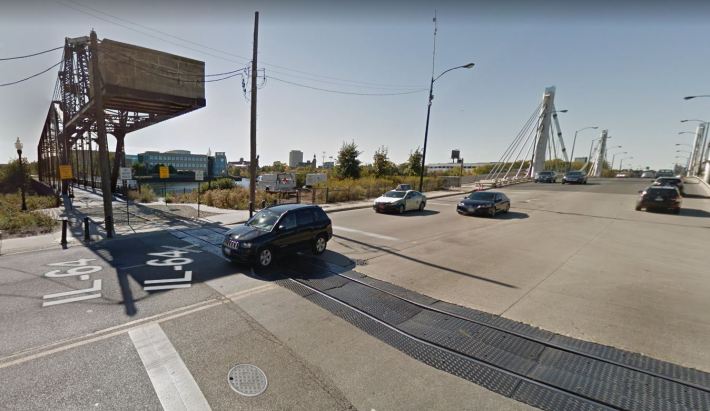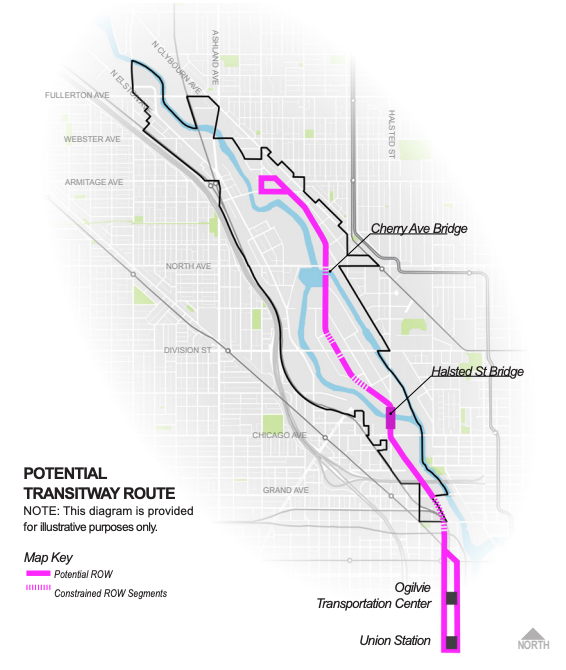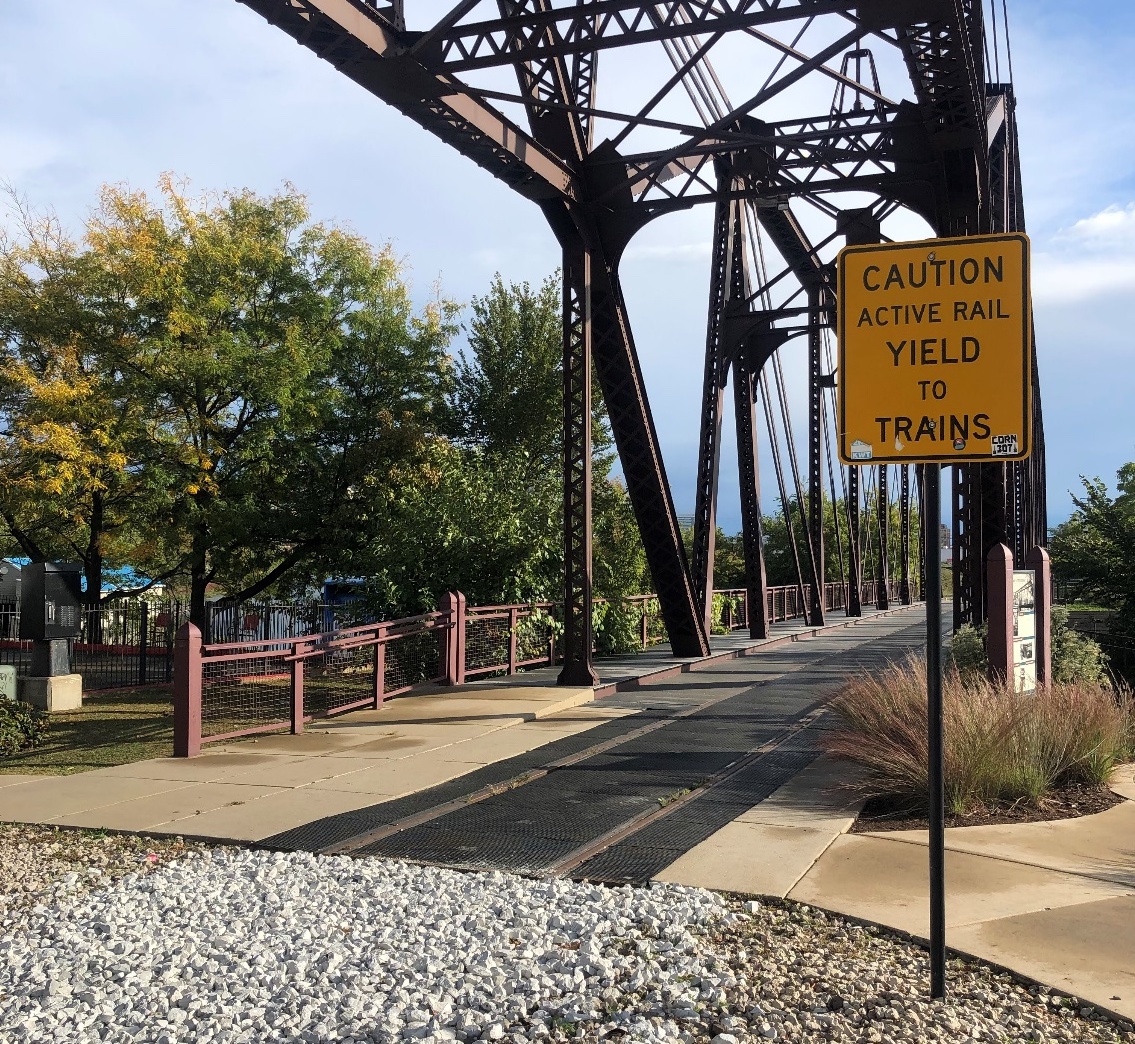Imagine biking over a bridge—directly on top of an active freight rail line. This seems like a bad idea, no? But since 2009, that has been the intended design of Goose Island’s Cherry Avenue Bridge, which connects the ever-industrious island with North Avenue. Or at least it was, until the city finally removed the rails from the bridge’s approach crossing North Avenue, putting an official end to over 110 years of regular freight service to the island. Still, the landmarked bridge has found a wonderful second life as a piece of bicycle and pedestrian infrastructure — and one of the nation’s more unusual ones at that — that will hopefully last for many years to come.
A lengthy freight history
Completed in 1902 by the Chicago, Milwaukee and St. Paul Railway, better known as the “Milwaukee Road,” the single-track swing bridge was part of an industrial spur serving Goose Island businesses. The bridge is no longer movable but was once able to “swing” nearly 90 degrees to the east to allow boats to pass.
Adaptive reuse rehab accommodates cyclists and pedestrians
The bridge was given historical landmark status in 2007, shortly before the 2008-09 rehab which earned it its unique trail on rail distinction. In 2011, Streetsblog Chicago editor John Greenfield interviewed the bridge rehab’s chief engineer Daniel Burke, who confirmed the cyclists needn’t stress fear risking their lives each time they cross the short 200-foot bridge. Burke estimated that the line’s only remaining customer, Big Bay Lumber, received only about two small shipments of lumber per week over the bridge, and all trains required flagmen walking in front as the train cruised at about five miles per hour. The flagmen were also necessary to get the train across the busy North Avenue, a crossing which did not even have flashing lights or gates.

Burke noted that the project was one of the first adaptive reuse projects of its kind. The post-rehab bridge features rubber ground panels between and around the rails, providing a safe, level surface much more comfortable for pedestrians and cyclists, as well as sidewalk and landscape improvements at both ends. Cars were not allowed. In 2013, the bridge began seeing increased pedestrian traffic from a new Chicago Water Taxi dock at its south end. During warmer months of the year, this most aesthetically-pleasing of transportation options provides rides from the Cherry Avenue Bridge to Madison Street in just 20 minutes.
End of the line for trains
Big Bay Lumber closed in 2015, which was likely the end of regular freight runs across the Cherry Avenue Bridge. But some unlikely bridge-enabled drama ensued in 2017. The rail line’s owner Iowa Pacific inexplicably shuttled two dozen empty tanker cars over the bridge and onto Goose Island, where the track often runs directly in the street, and stored them there indefinitely. Some local businesses, many of which rely on truck deliveries to and from their facilities on the island, were enraged, and accused Iowa Pacific of attempting a shakedown for cash. Developer Sterling Bay, whose interest in the area comes from their Lincoln Yards megadevelopment just to the north, also joined the fray, requesting intervention from the federal Surface Transportation Board.

The railroad eventually backed down and removed the cars in October 2017. It is quite possible that this was the last train to cross the bridge, 115 years after the first one. A year later, the city assumed control of the tracks.
In September 2020, the city finally removed the rails at the north end of the bridge, including those that cross North Avenue. The rails on the bridge and Goose Island remain, but with the North Avenue connection severed, there would be no way for a train to access them.


An increasingly multimodal future?
Although not directly within the Lincoln Yards property area, the bridge could become a key transportation asset for the project. A “transitway” proposed to connect Lincoln Yards with the Ogilvie Center and Union Station Metra terminals downtown would use the Cherry Avenue Bridge, along with much of the entire 1.8-mile former Chicago Terminal Railroad right-of-way. The city acquired the right-of-way for this purpose in late 2018. Sterling Bay purchased the right-of-way easement from the city for this purpose earlier this year. A specific transportation mode has not been determined, although light rail, bus rapid transit, and protected bicycle infrastructure have been discussed.

The proposed transitway has been covered extensively on Streetsblog. But many advocates have wondered if it’s the right project, seeing as it seems to primarily serve 9-to-5 Metra commuters while ignoring both Metra’s poor off-peak service levels and the need to improve the “last mile” connections between Lincoln Yards and the nearby Blue, Red, Brown, and Purple lines.
If the project does move forward though, the Cherry Avenue Bridge will represent a unique challenge: The existing bridge is only wide enough for one light rail track or bus lane. Barring a complete reconstruction, perhaps it remains best suited as a pleasant bicycle/pedestrian bridge. Ensuring it remains accessible for bike riders and pedestrians would be particularly useful considering that just a few blocks north, The 606 elevated trail is slated to be extended over another swing bridge that this rail spur used.





